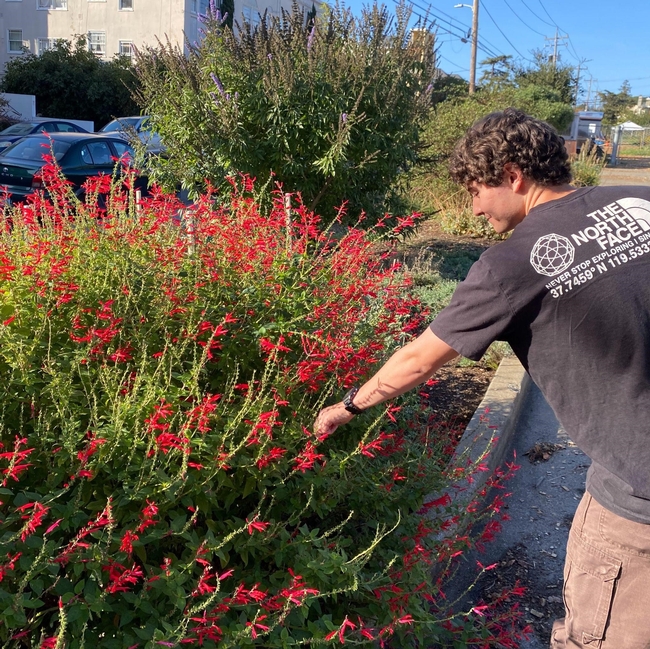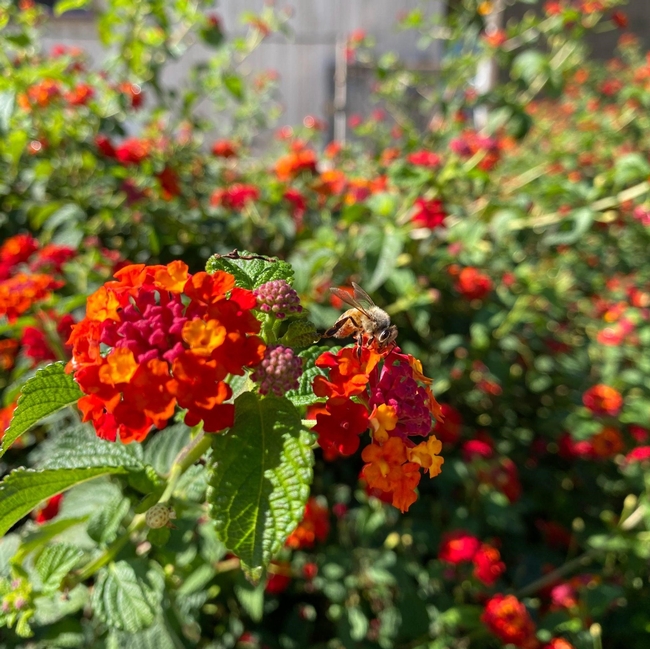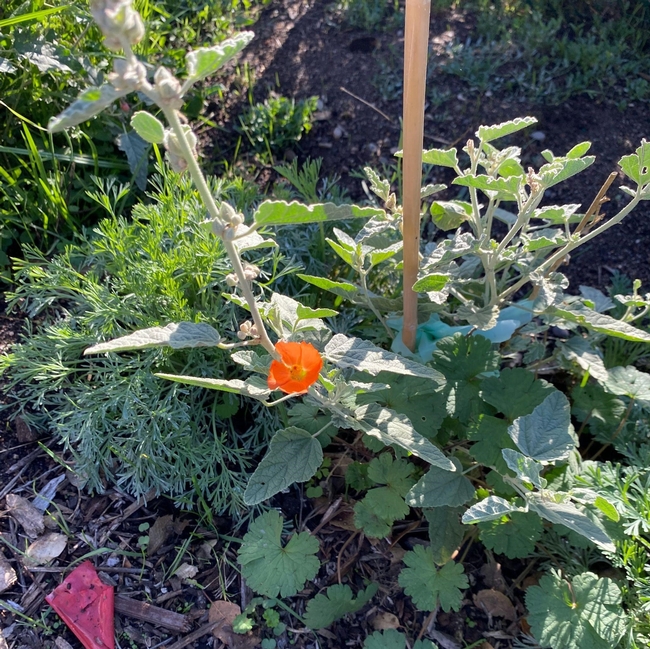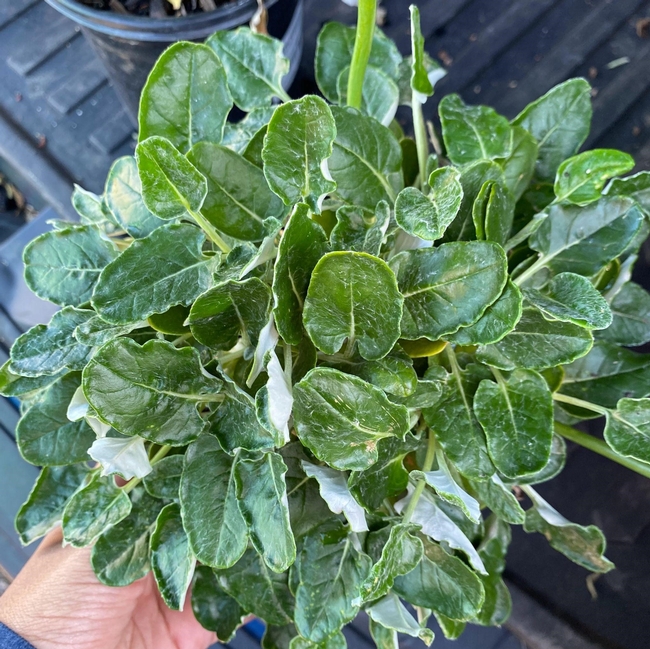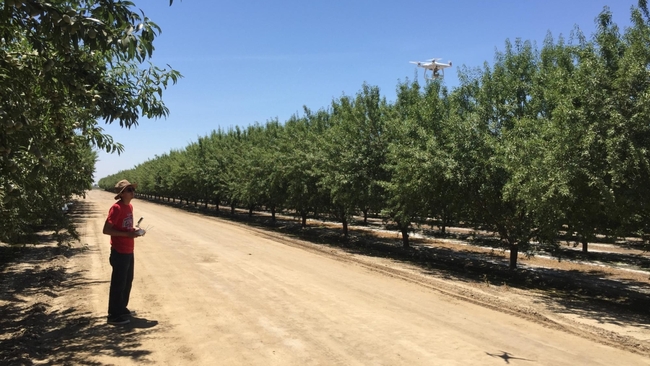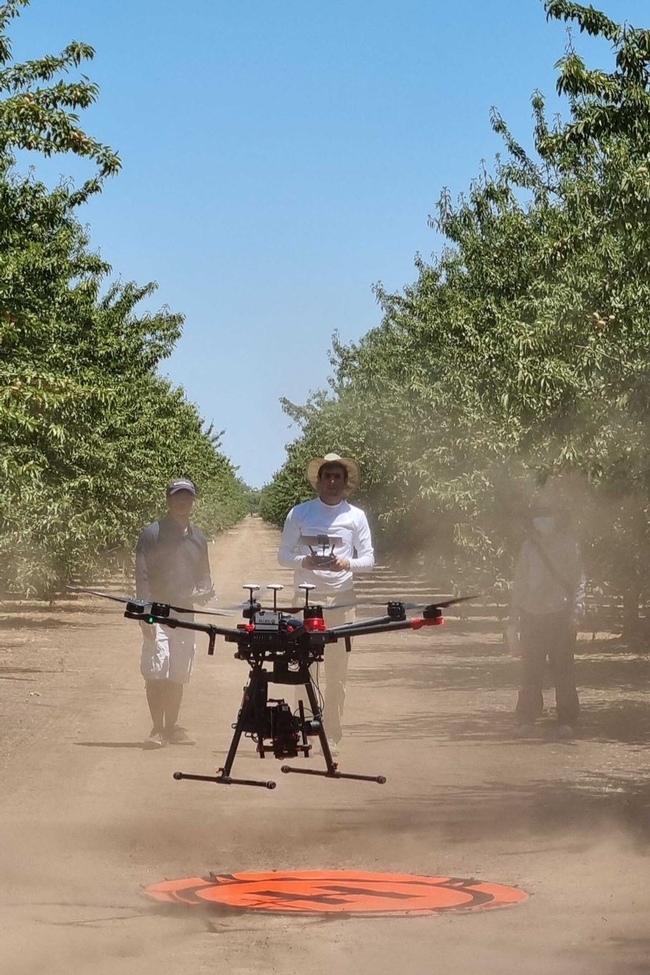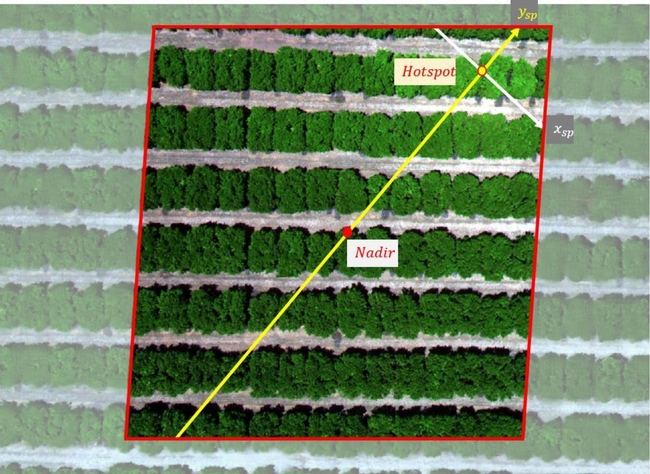Posts Tagged: climate resilience
Lawn-pocalypse! Surviving Drought
Ah, summer! The season of sunburns, pool parties, and… lawn droughts. If your once lush, green carpet now looks like a crunchy brown doormat, you're not alone. Let's dive into why your yard is staging a dramatic death scene and what you can do to...

Bermuda grass and weeds overtaking drought stressed turf grass.
UC Hopland Healthy Soils Project and The UC Berkeley Urban Bee Lab
The California Department of Food and Agriculture's Healthy Soil Program provides funding for on-farm initiatives aimed at implementing soil practices that reduce greenhouse gas emissions and enhance carbon storage. The UC Hopland Healthy Soils Project was created in collaboration with the Hopland Research and Extension Center (HREC) and undertaken by UC Berkeley's Dr. Gordon Frankie to assess the impact of various hedgerow plant species on pollinator diversity. Hedgerows typically consist of shrubs, trees, grasses, and flowering plants that offer various advantages to the surrounding farm ecosystem. These advantages include but are not limited to: weed control, windbreak, erosion control, improved air and water quality, biodiversity enhancement, and increased pollinator activity.
To measure the effect of the hedgerows on pollinator activity, Dr. Frankie and his team at the UC Berkeley Urban Bee Lab conduct bee surveys on both the treatment area (hedgerow) and the control area (weeds and grasses) four times a year during spring, summer, and fall. The ultimate objective of this project is to strike an ecological balance by selecting plant species that benefit a range of organisms such as bees, birds, butterflies, and others, while simultaneously mitigating greenhouse gas emissions and sequestering carbon in the farm soil.
Assistant Researcher Jerid Vega with Pineapple Sage (Salvia elegans) at the Urban Bee Lab Garden in Berkeley, CA
Dr. Frankie, with the UC Berkeley Department of Environmental Science, Policy, and Management, is an urban entomologist with over 25 years of experience focusing on the behavioral ecology and community organization of solitary bee species in specific environments within California and Costa Rica. Over the past two decades, Dr. Frankie has conducted extensive studies on bee diversity, seasonality, and host plant preferences at various sites in northern California and seasonal dry forests in Costa Rica. His research also involves monitoring changes in annual bee frequencies and mortality factors that may impact bee populations. Recently, Dr. Frankie's work has shifted from pure wildland studies to comparative bee studies in both wildlands and urban residential gardens, driven by the discovery that urban areas can support diverse local bee species. This shift aligns with a broader concern of global pollinator decline and the need to find new ways to conserve and protect pollinators across different habitats.
A pollinator visiting Lantana or Shrub Verbena (Lantana camara) at the Urban Bee Lab Garden in Berkeley, CA
Dr. Frankie and his assistant researcher Jerid Vega recently stopped by HREC to add herbaceous plants and flower seeds to their project's test hedgerow. Jerid graduated from Berkeley in the spring of 2023 with a B.S. in Molecular Biology from UC Berkeley's College of Natural Resources. Both Dr. Frankie and Jerid argue there is inherent value in recognizing what biodiversity is. “Supporting that biodiversity can be achieved through investments in smaller, more pollinator friendly gardens” says Vega.
Admittedly, Dr. Frankie acknowledges that picking plants for the hedgerow and observing their relationships with pollinator visitors is a very slow process. The time it takes for plant species to establish can be an obstacle to speedy species surveying. When asked how their research team selects and manages the plant species for a specific project, Dr. Frankie and Jerid credit nursery workers, master gardeners, and community members for their suggestions. Dr. Frankie's ideology on plant selection is collective, the product of conversation about pollinator activity from his team, colleagues, and master gardeners. “Those are the people who spend time with the plants, watching them far more than I do!” Dr. Frankie chimes.
Urban Bee Lab Garden in Berkeley, CA
The Desert Mallow and native Redflower Buckwheat (pictured below) are just two of the many plant species that Dr. Frankie and his research team are in the process of observing. These native wildflowers not only produce striking, colorful blooms but also offer a wealth of nectar and pollen, making them a valuable food source for bees, butterflies, and other beneficial insects. Their extended blooming periods, typically from spring through late summer, ensure a consistent supply of sustenance for pollinators throughout the season. Additionally, both plants are well-adapted to arid and semi-arid regions, making them resilient and low-maintenance choices for gardeners. The Desert Mallow and Redflower Buckwheat exemplify the harmonious relationship between native plants and their pollinator counterparts that enhances biodiversity and contributes to a healthier ecosystem.
It's important to recognize that these pretty flowers attract all kinds of insects that aren't as suitable to some as the docile hummingbird. “It's not just bumble bees that these plants attract, it's wasps and flies that do their own part in benefiting ecosystem biodiversity,” adds Jerid Vega. The myth of insect pollinators being inherently eager to sting humans can be a significant obstacle in the way of convincing people to plant pollinator-friendly gardens. This fear of insects perpetuates reluctance to support both wildland and urban insect populations. In reality, these insects are not naturally aggressive toward people. “They're primarily focused on foraging for nectar/pollen to feed their colonies, and will only sting as a last resort if they feel threatened or cornered” concludes Jerid.
Educating people about the behavior and importance of bees and other pollinators is crucial. Dispelling the myth that bees are out to sting us can encourage more individuals to embrace pollinator-attracting plants, contributing to the conservation of these vital species. Understanding the true nature of bees and their role in pollination can lead to a more harmonious coexistence between humans and these remarkable insects.
When asked what potential small gardens with pollinator-preferred species have to attract a high diversity of bee species, Dr. Frankie provided some examples of encouraging results starting with his lab at the Oxford Tract. When the Bee Lab first moved to this site off campus, they started with bare soil. Since moving there full time in 2020, the garden has attracted over sixty species of native bees. The Bee Lab has also consulted on community gardens outside of the Bay Area in the past, including Emerson Community Garden in San Luis Obispo and a Diverse Home Garden in Ukiah. Emerson Community Garden surveyed 5 native bee species pre-planting and 42 species post-establishment. Diverse Home Garden in Ukiah surpassed that of Emerson, surveying 65 bee species in total over the course of 12 years.
The Bee Lab does their work with the help of community educators and a select group of volunteers primarily composed of undergraduate students interested in entomology, resource studies, or environmental conservation. Dr. Frankie's team sifts through volunteer applications annually, and are attracted to students they know will stay on board and have an interest in community outreach. Despite The Bee Lab being a small non-profit entity, they still respond to any invitations they can asking for lessons about pollinator vs. plant relationships.
Learn more about the UC Berkeley Bee Lab here.
This project was supported by funding through the CDFA's Healthy Soils Demonstration Program and 'California Climate Investments'. The HREC Hedgerow Demonstration Project is part of California Climate Investments, a statewide initiative that puts billions of Cap-and-Trade dollars to work reducing greenhouse gas emissions, strengthening the economy, and improving public health and the environment - particularly in disadvantaged communities.
Researchers create app to help drones improve farm efficiency
When flown at the right times, drones can help farmers adapt to a changing climate
Researchers at the University of California, Davis, have developed a web application to help farmers and industry workers use drones and other uncrewed aerial vehicles, or UAVs, to generate the best possible data. By helping farmers use resources more efficiently, this advancement could help them adapt to a world with a changing climate that needs to feed billions.
Associate Professor Alireza Pourreza, director of the UC Davis Digital Agriculture Lab and postdoctoral researcher Hamid Jafarbiglu, who recently completed his doctorate in biological systems engineering under Pourreza, designed the When2Fly app to make drones more proficient and accurate. Specifically, the platform helps drone users avoid glare-like areas called hotspots that can ruin collected data.
Drone users select the date they plan to fly, the type of camera they are using and their location either by selecting a point on a map or by entering coordinates. The app then indicates the best times of that specific day to collect crop data from a drone.
Jafarbiglu and Pourreza, who is also a UC Cooperative Extension specialist of agricultural mechanization, said that using this app for drone imaging and data collection is crucial to improve farming efficiency and mitigate agriculture's carbon footprint. Receiving the best data — like what section of an orchard might need more nitrogen or less water, or what trees are being affected by disease — allows producers to allocate resources more efficiently and effectively.
"In conventional crop management, we manage the entire field uniformly assuming every single plant will produce a uniform amount of yield, and they require a uniform amount of input, which is not an accurate assumption," said Pourreza. "We need to have an insight into our crops' spatial variability to be able to identify and address issues timely and precisely, and drones are these amazing tools that are accessible to growers, but they need to know how to use them properly."
Dispelling the solar noon belief
In 2019, Jafarbiglu was working to extract data from aerial images of walnut and almond orchards and other specialty crops when he realized something was wrong with the data.
"No matter how accurately we calibrated all the data, we were still not getting good results," said Jafarbiglu. "I took this to Alireza, and I said, 'I feel there's something extra in the data that we are not aware of and that we're not compensating for.' I decided to check it all."
Jafarbiglu pored through the 100 terabytes of images collected over three years. He noticed that after the images had been calibrated, there were glaring bright white spots where they were supposed to look flat and uniform.
But it couldn't be a glare because the sun was behind the drone taking the image. So Jafarbiglu reviewed literature going back to the 1980s in search of other examples of this phenomenon. Not only did he find mentions of it, but also that researchers had coined a term for it: hotspot.
A hotspot happens when the sun and UAV are lined up in such a way that the drone is between the viewable area of the camera's lens system and the sun. The drone takes photos of the Earth, and the resulting images have a gradual increase in brightness toward a certain area. That bright point is the hotspot.
The hotspots are a problem, Jafarbiglu said, because when collecting UAV data in agriculture, where a high level of overlap is required, observed differences in the calibrated images need to come solely from plant differences.
For example, every plant may appear in 20 or more images, each from varying view angles. In some images, the plant might be close to the hotspot, while in others it may be situated further away, so the reflectance may vary based on the plant's distance from the hotspot and spatial location in the frame, not based on any of the plant's inherent properties. If all these images are combined into a mosaic and data are extracted, the reliability of the data would be compromised, rendering it useless.
Pourreza and Jafarbiglu found that the hotspots consistently occurred when drones were taking images at solar noon in mid-summer, which many believe is the best time to fly drones. It's an obvious assumption: the sun is at its highest point above the Earth, variations in illumination are minimal, if not steady and fewer shadows are visible in the images. However, sometimes that works against the drone because the sun's geometrical relationship to the Earth varies based on location and the time of year, increasing the chance of having a hotspot inside the image frame when the sun is higher in the sky.
"In high-latitude regions such as Canada, you don't have any problem; you can fly anytime. But then in low-latitude regions such as California, you will have a little bit of a problem because of the sun angle," Pourreza said. "Then as you get closer to the equator, the problem gets bigger and bigger. For example, the best time of flight in Northern California and Southern California will be different. Then you go to summer in Guatemala, and basically, from 10:30 a.m. to almost 2 p.m. you shouldn't fly, depending on the field-oriented control of the camera. It's exactly the opposite of the conventional belief, that everywhere we should fly at solar noon."
Grow technology, nourish the planet
Drones are not the only tools that can make use of this discovery, which was funded by the AI Institute for Next Generation Food Systems. Troy Magney, an assistant professor of plant sciences at UC Davis, mainly uses towers to scan fields and collect plant reflectance data from various viewing angles. He contacted Jafarbiglu after reading his research, published in February in the ISPRS Journal of Photogrammetry and Remote Sensing, because he was seeing a similar issue in the remote sensing of plants and noted that it's often ignored by end users.
"The work that Hamid and Ali have done will be beneficial to a wide range of researchers, both at the tower and the drone scale, and help them to interpret what they are actually seeing, whether it's a change in vegetation or a change in just the angular impact of the signal," he said.
For Pourreza, the When2Fly app represents a major step forward in deploying technology to solve challenges in agriculture, including the ultimate conundrum: feeding a growing population with limited resources.
"California is much more advanced than other states and other countries with technology, but still our agriculture in the Central Valley uses technologies from 30 to 40 years ago," said Pourreza. "My research is focused on sensing, but there are other areas like 5G connectivity and cloud computing to automate the data collection and analytics process and make it real-time. All this data can help growers make informed decisions that can lead to an efficient food production system. When2Fly is an important element of that."
This article was originally published on the UC Davis College of Engineering News page.
Climate-Change Resources
University of California UC ANR Green Blog (Climate Change and Other Topics) https://ucanr.edu/blogs/Green/index.cfm?tagname=climate%20change (full index)
Examples:
- Save Trees First: Tips to Keep Them Alive Under Drought https://ucanr.edu/b/~CdD
- Landscaping with Fire Exposure in Mind: https://ucanr.edu/b/~G4D
- Cities in California Inland Areas Must Make Street Tree Changes to adapt to Future Climate https://ucanr.edu/b/~oF7
Drought, Climate Change and California Water Management Ted Grantham, UC Cooperative Extension specialist (23 minutes) https://youtu.be/dlimj75Wn9Q
Climate Variability and Change: Trends and Impacts on CA Agriculture Tapan Pathak, UC Cooperative Extension specialist (24 minutes) https://youtu.be/bIHI0yqqQJc
California Institute for Water Resources (links to blogs, talks, podcasts, water experts, etc.) https://ciwr.ucanr.edu/California_Drought_Expertise/
UC ANR Wildfire Resources (publications, videos, etc.) https://ucanr.edu/News/For_the_media/Press_kits/Wildfire/ (main website)
-UC ANR Fire Resources and Information https://ucanr.edu/sites/fire/ (main website)
-Preparing Home Landscaping https://ucanr.edu/sites/fire/Prepare/Landscaping/
UC ANR Free Publications https://anrcatalog.ucanr.edu/ (main website)
- Benefits of Plants to Humans and Urban Ecosystems: https://anrcatalog.ucanr.edu/pdf/8726.pdf
-Keeping Plants Alive Under Drought and Water Restrictions (English version) https://anrcatalog.ucanr.edu/pdf/8553.pdf
(Spanish version) https://anrcatalog.ucanr.edu/pdf/8628.pdf
- Use of Graywater in Urban Landscapes https://anrcatalog.ucanr.edu/pdf/8536.pdf
- Sustainable Landscaping in California https://anrcatalog.ucanr.edu/pdf/8504.pdf
Other (Non-UC) Climate Change Resources
Urban Forests and Climate Change. Urban forests play an important role in climate change mitigation and adaptation. Active stewardship of a community's forestry assets can strengthen local resilience to climate change while creating more sustainable and desirable places to live. https://www.fs.usda.gov/ccrc/topics/urban-forests
Examining the Viability of Planting Trees to Mitigate Climate Change (plausible at the forest level) https://climate.nasa.gov/news/2927/examining-the-viability-of-planting-trees-to-help-mitigate-climate-change/
Reports and other information resources coordinated under the auspices of the United Nations and produced through the collaboration of thousands of international scientists to provide a clear and up to date view of the current state of scientific knowledge relevant to climate change. United Nations Climate Action
Scientific reports, programs, action movements and events related to climate change. National Center for Atmospheric Research (National Science Foundation)
Find useful reports, program information and other documents resulting from federally funded research and development into the behavior of the atmosphere and related physical, biological and social systems. Search and find climate data from prehistory through to an hour ago in the world's largest climate data archive. (Formerly the "Climatic Data Center") National Centers for Environmental Information (NOAA)
Think tank providing information, analysis, policy and solution development for addressing climate change and energy issues (formerly known as the: "Pew Center on Global Climate Change"). Center for Climate & Energy Solutions (C2ES)
Mapping Resilience: A Blueprint for Thriving in the Face of Climate Disaster. The Climate Adaptation Knowledge Exchange (CAKE) was launched in July 2010 and is managed by EcoAdapt, a non-profit with a singular mission: to create a robust future in the face of climate change by bringing together diverse players to reshape planning and management in response to rapid climate change. https://www.cakex.org/documents/mapping-resilience-blueprint-thriving-face-climate-disaster
Cal-Adapt provides a way to explore peer-reviewed data that portrays how climate change might affect California at the state and local level. We make this data available through downloads, visualizations, and the Cal-Adapt API for your research, outreach, and adaptation planning needs. Cal-Adapt is a collaboration between state agency funding programs, university and private sector researchers https://cal-adapt.org/
Find reports, maps, data and other resources produced through a confederation of the research arms of 13 Federal departments and agencies that carry out research and develop and maintain capabilities that support the Nation's response to global change. Global Change (U.S. Global Change Research Program)
The Pacific Institute is a global water think tank that combines science-based thought leadership with active outreach to influence local, national, and international efforts to develop sustainable water policies. https://pacinst.org/our-approach/
Making equity real in climate adaptation and community resilience policies and programs: a guidebook. https://greenlining.org/publications/2019/making-equity-real-in-climate-adaption-and-community-resilience-policies-and-programs-a-guidebook/
Quarterly CA Climate Updates and CA Drought Monitor Maps (updated each Thursday) https://www.drought.gov/documents/quarterly-climate-impacts-and-outlook-western-region-june-2022
Drought focus of Water Resources IMPACT magazine special issue
UC ANR experts address emotional toll of drought
Preparing the American West for prolonged drought is the focus of a double issue of Water Resources IMPACT magazine. The California Water Commission staff are guest editors for this special open-access edition of the magazine, which is published by the American Water Resources Association.
Faith Kearns, academic coordinator of University of California Agriculture and Natural Resources' California Institute for Water Resources, is among the authors delving into how drought impacts people and the environment and how we can better prepare for the inevitable.
The first issue, published on Feb. 14, focuses on water scarcity issues confronting California and the ways these issues affect different sectors.
In “Trauma, Care, and Solidarity: Addressing the Emotional Toll of Chronic Drought,” Kearns highlights the effects of drought on mental health. She points to the spike in suicide hotline calls when wells ran dry in Southeast Asian communities in California's Central Valley.
By listening to Southeast Asian farmers, Ruth Dahlquist-Willard and Michael Yang of UC Cooperative Extension were able to “lighten the load” for them by providing pragmatic support, Kearns writes.
“The scale of some of these highly emotional issues – drought, wildfires, climate change – can make them seem incredibly difficult, if not impossible, to deal with,” Kearns said. “At the same time, they are affecting everyone living in the western U.S. on a daily basis. I wanted to highlight and provide models based on work that people – whether they are researchers, clinical psychologists, or Cooperative Extension advisors – are doing right now to ease the way.”
The authors who contributed to the double issue are a diverse array of Tribal experts, academics, nongovernmental organization thought-leaders, water managers and water policy influencers, each of whom brings their own perspective on the topic of drought. Their expertise and perspectives in climate science, water policy and water management will help inform drought-related decision-making and support policies that better prepare the state to thrive during periods of prolonged water scarcity.
In addition to Kearns, the first issue includes articles contributed by:
- Samantha Stevenson, University of California, Santa Barbara
- Jay Lund, University of California, Davis
- Ron Goode, North Fork Mono Tribe
- Andy Fecko, Placer County Water Agency
- Jeff Mount, Public Policy Institute of California, and Ted Grantham, University of California, Berkeley/UC Cooperative Extension
- Nat Seavy and Karyn Stockdale, National Audubon Society
- Kjia Rivers, Community Water Center
- Cannon Michael, Bowles Farming
- Michelle Reimers, Turlock Irrigation District
The January/February edition of Water Resources IMPACT magazine can be accessed, free of charge, on the American Water Resources Association website at https://www.awra.org under “Publications.”
The second issue, to be published in March, will focus on drought response, considering the options for adaptation. This two-part series complements the Commission's work on strategies to protect communities and fish and wildlife in the event of a long-term drought.

